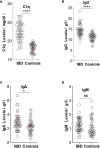Leaky gut, circulating immune complexes, arthralgia, and arthritis in IBD: coincidence or inevitability?
- PMID: 38571963
- PMCID: PMC10987687
- DOI: 10.3389/fimmu.2024.1347901
Leaky gut, circulating immune complexes, arthralgia, and arthritis in IBD: coincidence or inevitability?
Abstract
Most host-microbiota interactions occur within the intestinal barrier, which is essential for separating the intestinal epithelium from toxins, microorganisms, and antigens in the gut lumen. Gut inflammation allows pathogenic bacteria to enter the blood stream, forming immune complexes which may deposit on organs. Despite increased circulating immune complexes (CICs) in patients with inflammatory bowel disease (IBD) and discussions among IBD experts regarding their potential pathogenic role in extra-intestinal manifestations, this phenomenon is overlooked because definitive evidence demonstrating CIC-induced extra-intestinal manifestations in IBD animal models is lacking. However, clinical observations of elevated CICs in newly diagnosed, untreated patients with IBD have reignited research into their potential pathogenic implications. Musculoskeletal symptoms are the most prevalent extra-intestinal IBD manifestations. CICs are pivotal in various arthritis forms, including reactive, rheumatoid, and Lyme arthritis and systemic lupus erythematosus. Research indicates that intestinal barrier restoration during the pre-phase of arthritis could inhibit arthritis development. In the absence of animal models supporting extra-intestinal IBD manifestations, this paper aims to comprehensively explore the relationship between CICs and arthritis onset via a multifaceted analysis to offer a fresh perspective for further investigation and provide novel insights into the interplay between CICs and arthritis development in IBD.
Keywords: antigen-antibody complex; arthritis; complement; inflammatory bowel diseases; leaky gut; mitochondrial dysfunction.
Copyright © 2024 Jin, Li, Quan, Chao and Zhang.
Conflict of interest statement
The authors declare that the research was conducted in the absence of any commercial or financial relationships that could be construed as a potential conflict of interest.
Figures


Similar articles
-
Impact of vedolizumab therapy on extra-intestinal manifestations in patients with inflammatory bowel disease: a multicentre cohort study nested in the OBSERV-IBD cohort.Aliment Pharmacol Ther. 2018 Feb;47(4):485-493. doi: 10.1111/apt.14419. Epub 2017 Dec 18. Aliment Pharmacol Ther. 2018. PMID: 29250803
-
Current insights on the roles of gut microbiota in inflammatory bowel disease-associated extra-intestinal manifestations: pathophysiology and therapeutic targets.Gut Microbes. 2023 Dec;15(2):2265028. doi: 10.1080/19490976.2023.2265028. Epub 2023 Oct 11. Gut Microbes. 2023. PMID: 37822139 Free PMC article. Review.
-
The Impact of Inflammatory Bowel Disease in Canada 2018: Extra-intestinal Diseases in IBD.J Can Assoc Gastroenterol. 2019 Feb;2(Suppl 1):S73-S80. doi: 10.1093/jcag/gwy053. Epub 2018 Nov 2. J Can Assoc Gastroenterol. 2019. PMID: 31294387 Free PMC article.
-
Dismicrobism in inflammatory bowel disease and colorectal cancer: changes in response of colocytes.World J Gastroenterol. 2014 Dec 28;20(48):18121-30. doi: 10.3748/wjg.v20.i48.18121. World J Gastroenterol. 2014. PMID: 25561781 Free PMC article. Review.
-
Leaky Gut in IBD: Intestinal Barrier-Gut Microbiota Interaction.J Microbiol Biotechnol. 2022 Jul 28;32(7):825-834. doi: 10.4014/jmb.2203.03022. Epub 2022 Jun 30. J Microbiol Biotechnol. 2022. PMID: 35791076 Free PMC article. Review.
Cited by
-
Evaluating the anti-inflammatory and antioxidant efficacy of complementary and alternative medicines (CAM) used for management of inflammatory bowel disease: a comprehensive review.Redox Rep. 2025 Dec;30(1):2471737. doi: 10.1080/13510002.2025.2471737. Epub 2025 Mar 8. Redox Rep. 2025. PMID: 40056427 Free PMC article. Review.
References
Publication types
MeSH terms
Substances
LinkOut - more resources
Full Text Sources
Medical
Miscellaneous

